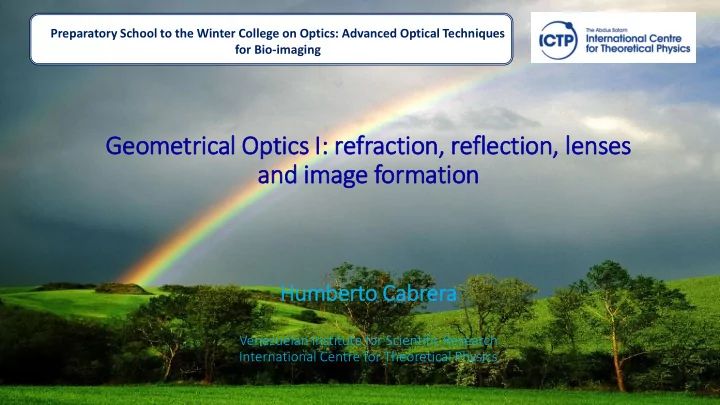

Preparatory School to the Winter College on Optics: Advanced Optical Techniques for Bio-imaging Geometrical Optics I: I: refraction, , reflection, , le lenses and im image formation Humberto Cabrera Venezuelan Institute for Scientific Research International Centre for Theoretical Physics
Refraction, reflection, lenses, and image formation Basi asic components and nd th their ir fu functions What is is in insi side?
Topics: 1. Propert rtie ies o lig light 2. . Lig ight matter in interactio ion 3. . Refr fractio ion and refl flectio ion. Refr fractiv ive len lenses 4. . Im Image form rmatio ion
Propertie ies of lig light. . Ele lectromagnetic ic spectrum
Ele lectromagnetic ic spectrum and tis issue absorption
Propertie ies of lig light. . Waves am ampli litude E wavelength ( λ ) frequency ( ν ) speed (c) phas ase ( ϕ ) pola olarization in intensity (I) λν = c
Propertie ies of lig light. . Waves Wavelength: λ =635 nm I=P/A=250 W/m 2 Power: P=2 mW E=430 V/m Spot (area): A=8 mm Spot (area) =8 mm Speed: c=3.00×10 8 m/s Speed (c)=3.00×10 8 m/s Area: A=8 mm 2 ν =5x10 14 Hz ε 0 = 8.854 187 817... × 10 −12 F ⋅ m
Propertie ies of lig light. . Speed n=1 n>1 n=1
Propertie ies of lig light. . Rays and wavefronts (To simplify drawing light, rays and wavefronts are used instead)
Light matter interaction. Refraction and reflection
Lig ight matter in interaction. . Snell ll´s la law
Lig ight matter in interaction. . Fresnel l equations for normal l in incid idence ~4 ~4% for air air-glass ~96% for air-glass
Refractiv ive le lenses. . Focusing Lens maker´s equation: where n is the index of refraction of the lens material, and R 1 and R 2 are the radii of curvature of the two surfaces. For a thin lens, d is much smaller than one of the radii of curvature (either R 1 or R 2 )
Refractiv ive le lenses. . Lens shapes
Refractiv ive le lenses. . Focus siz ize Is the focus really a point?, No, the focus has a size proportional to the wavelength Airy disk
Refractive lenses. Aberrations
Refractive lenses. Ray tracing 1. Any ray that enters parallel to the axis on one side of the lens proceeds towards the focal point f on the other side 2. Any ray that arrives at the lens after passing through the focal point on the front side, comes out parallel to the axis on the other side 3. Any ray that passes through the center of the lens will not change its direction
Refractive lenses. Ray tracing With ray tracing rules 1, 2 and 3, the position and size of an image can be determined from the position and size of an object By tracing these rays, the relationship between the object distance and the image distance can be shown to be (thin lens equation): 𝟐 + 𝟐 = 𝟐 𝑻 𝟐 𝑻 𝟑 𝒈 And the magnification of the image: 𝑵 = − 𝑻 𝟑 = 𝒊 𝟑 𝑻 𝟐 𝒊 𝟐
https://www.youtube.com/watch?v=OSUGRvYwxw8
Image formation: Real and virtual images https://www.youtube.com/watch?v=mfytZxM8lho
Recommend
More recommend